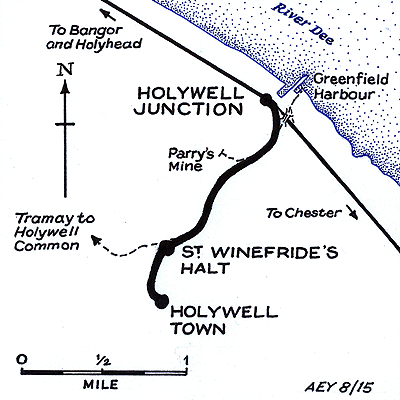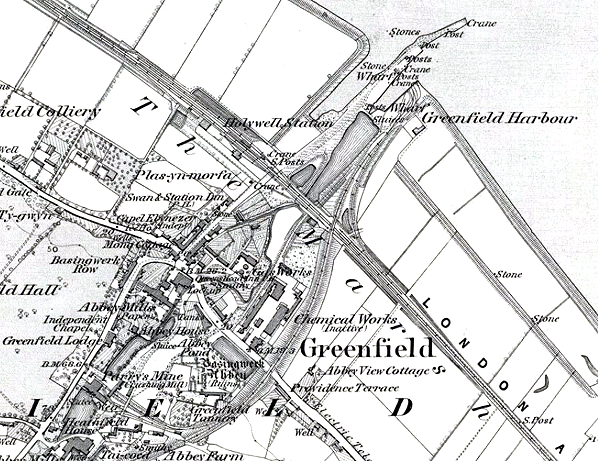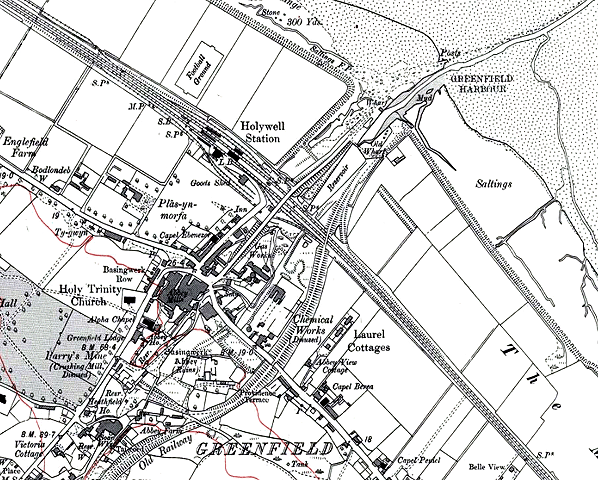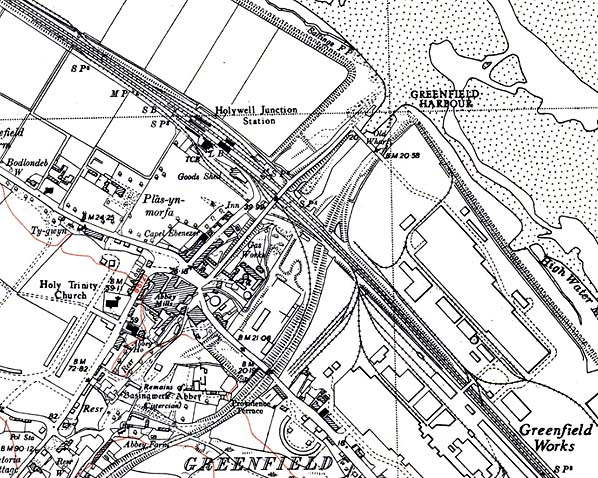Notes: Holywell Junction was situated on the Chester & Holyhead Railway (C&H) which was authorised on 4 July 1844. The line was a strategically important route as Holyhead was the port from which boats sailed to Kingstown (now Dun Laoghaire) for Dublin. It was engineered by Robert Stephenson and the section on which Holywell Junction was located opened on 1 May 1848. Holywell Junction opened as simply ‘Holywell’, the ‘Junction’ suffix being added when the branch opened to Holywell Town.
 Holywell station was located in the small settlement of Greenfield, the town after which it was named being 1¾ miles to the south on the northern flank of Halkyn Mountain. Greenfield was on the banks of the River Dee and had a harbour linked to industries in the Holywell area by a tramway which crossed the C&H line on the level to the south-east of the station. Holywell station was located in the small settlement of Greenfield, the town after which it was named being 1¾ miles to the south on the northern flank of Halkyn Mountain. Greenfield was on the banks of the River Dee and had a harbour linked to industries in the Holywell area by a tramway which crossed the C&H line on the level to the south-east of the station.
The station was a short distance west of the harbour and north of the settlement of Greenfield. Access was via Station Road which linked to the Chester and Bangor road.
The C&H was a double-track railway and the station’s main facilities were on the down side (Holyhead direction) of the line. They were housed in a large brick building of distinctive style, designed by the architect Francis Thompson, whose talents were also used on the North Midland Railway (Derby-Leeds) and the Eastern Counties Railway. The building is still standing and enjoys Grade II* listing. Biddle (Britain’s historic railway buildings, OUP 2003) describes Holywell Junction station as the best of his Chester & Holyhead stations and endorses the assessment of earlier writers that it is an admirably balanced composition, the detailing sophisticated and restrained. It is reminiscent of an elegant brick Italianate villa. Its front and platform elevations are composed of three round-headed ground-floor openings and flat hoods to the corresponding windows above, linked by white stone bands. A broad frieze is adorned with rose motifs, surmounted by a pantiled, near-flat roof. The low side-wings had a slender Romanesque pavilion at each outer corner, but those at the front have gone, and the flat awning between the pair on the platform has also disappeared.
Originally there were no facilities on the up platform.
Because of the harbour Holywell had substantial goods facilities which included a brick-built goods shed, located on the down side of the line to the south-east of the station, sidings on both sides of the line and a lifting crane on the up side.
When the station opened the line extended only to Bangor (a bridge over the Menai Strait between Wales and the island of Anglesey still being under construction) so passenger services ran between there and Chester. Connections to Holyhead were available by coach to Llanfair PG on Anglesey from where the line had been completed to Holyhead. The February 1863 timetable showed eight weekday and four Sunday up trains to Chester. There was one train fewer each day in the down direction.
The bridge over the Menai Strait opened on 18 March 1850 and services were able to run direct to Holyhead.
 On 1 January 1859 the C&H was taken over by the London & North Western Railway (LNWR). On 1 January 1859 the C&H was taken over by the London & North Western Railway (LNWR).
In 1867 the freight-only Holywell Railway (HR) was opened which ran mostly along the route of the tramway. At Greenfield, however, the line ran on a new alignment slightly east of the tramway route and it passed over the main line on a bridge rather than on the level as the tramway had done. There was also a connection put in which curved eastwards from the harbour to link with the main line in a Chester-facing direction. By the late 1870s many of the industries which the HR served had gone and it went into receivership. The line was closed and lifted but its course remained intact.
By the late nineteenth century traffic levels along the former C&H had built up to such a level that the LNWR decided to quadruple many sections of it including that which ran through Holywell station. To accommodate the quadrupling the up platform was converted to an island with two faces and a new timber platform was built on the north side of the line. The original down line became the down slow and the original up became the down fast. The two new lines became the up fast and slow, the new timber platform serving the up slow.
The island platform was provided with a single-storey brick building under a hipped slate roof. A flat awning with a valance surrounded the building. The up slow line platform also had facilities located in a single-storey timber building with a hipped slate roof and a flat awning with a valance; this structure appears to have been of a standard LNWR design. A subway located at the north-west end of the station linked the platforms.
To control movements along the line the LNWR provided a signal box just beyond the north-west end of the island platform.
The December 1895 timetable showed nine up and seven down services Monday-to-Friday. There was an extra train in each direction on Saturdays. On sundays there were three up and two down trains.
 In 1905, having previously operated a steam lorry service between the main line station and the town, the LNWR introduced a motor bus service between Holywell Junction and Holywell Town. This proved very successful and it resulted in the LNWR giving consideration to opening a branch to Holywell along the course of the HR which it had bought in 1891. Various ideas had been put forward since the purchase including the creation of an electric tramway, but the decision was taken to construct a conventional branch railway, albeit on a punishingly steep gradient. To create the line a new spur was built from the south-east end of the station. It curved southwards to pick up the course of the original line. To serve the spur a bay platform was built at the south-east end of the down slow line platform. The line opened on 1 July 1912 and the southern terminus was called Holywell Town; on this date Holywell station was renamed Holywell Junction. In 1905, having previously operated a steam lorry service between the main line station and the town, the LNWR introduced a motor bus service between Holywell Junction and Holywell Town. This proved very successful and it resulted in the LNWR giving consideration to opening a branch to Holywell along the course of the HR which it had bought in 1891. Various ideas had been put forward since the purchase including the creation of an electric tramway, but the decision was taken to construct a conventional branch railway, albeit on a punishingly steep gradient. To create the line a new spur was built from the south-east end of the station. It curved southwards to pick up the course of the original line. To serve the spur a bay platform was built at the south-east end of the down slow line platform. The line opened on 1 July 1912 and the southern terminus was called Holywell Town; on this date Holywell station was renamed Holywell Junction.
An intensive shuttle service was operated between Holywell Junction and Holywell Town which within a few years had reached sixteen trains in each direction. The July 1922 timetable showed eighteen departures for Holywell Town with the same number of arrivals.
On 1 January 1923 Holywell Junction became part of the London Midland & Scottish Railway (LMS). The LMS summer timetable for 1932 showed sixteen up and sixteen down trains on the main line Monday-to-Friday with an extra up train on Wednesdays. On Saturdays there were seventeen trains in each direction. On Sundays there were four up and three down trains.
The Holywell branch had twenty-three trains in each direction Monday-to-Friday with an extra train on Wednesdays. On saturdays there were twenty-five trains each way but the branch had no Sunday service.
There was a cut-back to the level of services during the Second World War.
Holywell Junction became part of British Railways [London Midland Region] (BR[LMR]) on 1 January 1948.
 |
By the early 1950s traffic had built up to pre-war levels on the main line especially on summer Saturdays when many holiday trains were run. The main line remained busy but the Holywell Town branch service was proposed for withdrawal in 1954 and the last trains ran on Saturday 4 September 1954.
Holywell Junction was re-signed in the late 1950s with LMR totem nameplates and vitreous enamel running-in nameboards. It is thought that the station was lit by gas until closure.
The summer timetable for 1962 showed eighteen up and nineteen down trains Monday-to-Friday. On Saturdays there were fifteen up and eighteen down trains. The Sunday service consisted of nine up and eleven down trains.
 The Reshaping of British Railways (‘Beeching Report’) of March 1963 made grim reading for the Chester to Holyhead route. Of the 24 intermediate stations only four would remain open: Rhyl, Colwyn Bay, Llandudno Junction and Bangor. The formal proposal of the closure of these stations was published on 15 October 1964 and the Transport Users’ Consultative Committee report was presented to Tom Fraser, Secretary of State for Transport, on 23 April 1965. His decision, summarised in Hansard (28 February 1966) as ‘part refusal and part deferred’, was published on 19 November 1965, as a result of which eight of the stations proposed for closure were saved while 12 – one of which was Holywell Junction – were to close. The importance of tourism to their economy secured the survival of several stations, notably Prestatyn and Penmaenmawr, whilst in Anglesey the relative inaccessibility of Bodorgan, Ty Croes and Rhosneigr, rather than their importance, has kept them on the railway map to this day. The passenger train service to and from Holywell Junction, and the others approved for closure, was withdrawn on 14 February 1966. The excesses of the 1960s closure culture were corrected from the 1970s onwards, with stations reopened at Shotton (Low Level), Conwy, Llanfair PG and Valley. Goods traffic was handled at Holywell Junction until 2 July 1973, but sidings at the station remained in use for some years after. The Reshaping of British Railways (‘Beeching Report’) of March 1963 made grim reading for the Chester to Holyhead route. Of the 24 intermediate stations only four would remain open: Rhyl, Colwyn Bay, Llandudno Junction and Bangor. The formal proposal of the closure of these stations was published on 15 October 1964 and the Transport Users’ Consultative Committee report was presented to Tom Fraser, Secretary of State for Transport, on 23 April 1965. His decision, summarised in Hansard (28 February 1966) as ‘part refusal and part deferred’, was published on 19 November 1965, as a result of which eight of the stations proposed for closure were saved while 12 – one of which was Holywell Junction – were to close. The importance of tourism to their economy secured the survival of several stations, notably Prestatyn and Penmaenmawr, whilst in Anglesey the relative inaccessibility of Bodorgan, Ty Croes and Rhosneigr, rather than their importance, has kept them on the railway map to this day. The passenger train service to and from Holywell Junction, and the others approved for closure, was withdrawn on 14 February 1966. The excesses of the 1960s closure culture were corrected from the 1970s onwards, with stations reopened at Shotton (Low Level), Conwy, Llanfair PG and Valley. Goods traffic was handled at Holywell Junction until 2 July 1973, but sidings at the station remained in use for some years after.
The island platform and the up slow line platform of Holywell Junction station were demolished after closure but the down slow platform remains in place and the original C&H station building survives, converted into a private dwelling. In August 2015 there were still four tracks running through the site of Holywell Junction and the LNWR signal box was still in use.
For a full history of the Chester - Holyhead line see the North Wales Coast Railway web site
Further reading: The Chester & Holyhead Railway by Peter E. Baughan (1972) - Volume 1 & 2, Published by David & Charles ISBN 10-0715356178 and Regional History of the Railways of Great Britain Vol. 11, North & Mid Wales by P.E. Baughan, published by David & Charles (1991) ISBN-10: 0946537593.
Tickets from Michael Stewart and route map by Alan Young.
To see other stations on the Chester - Holyhead line click on the station name: Sandycroft, Queensferry, Connahs Quay, Bagillt, Mostyn, Talacre, Prestatyn (1st site), Prestatyn (2nd site and Dystrth branch platform), Foryd, Llandulas, Llysfaen, Old Colwyn, Mochdre & Pabo, Llandudno Junction (1st site) Conway, Conway Marsh, Llanfairfechan, Aber, Menai Bridge, Britannia Bridge, Gaerwen & Valley
See also Holywell Town branch: St Winefride's Halt and Holywell Town |

junction_old2.jpg)




junction_old1.jpg)
junction_old3.jpg)
junction JMC 2.jpg)
junction_old5.jpg)
junction1.jpg)
junction8.jpg)
.jpg)

 Holywell station was located in the small settlement of Greenfield, the town after which it was named being 1¾ miles to the south on the northern flank of Halkyn Mountain. Greenfield was on the banks of the River Dee and had a harbour linked to industries in the Holywell area by a tramway which crossed the C&H line on the level to the south-east of the station.
Holywell station was located in the small settlement of Greenfield, the town after which it was named being 1¾ miles to the south on the northern flank of Halkyn Mountain. Greenfield was on the banks of the River Dee and had a harbour linked to industries in the Holywell area by a tramway which crossed the C&H line on the level to the south-east of the station. On 1 January 1859 the C&H was taken over by the London & North Western Railway (LNWR).
On 1 January 1859 the C&H was taken over by the London & North Western Railway (LNWR).  In 1905, having previously operated a steam lorry service between the main line station and the town, the LNWR introduced a motor bus service between Holywell Junction and Holywell Town. This proved very successful and it resulted in the LNWR giving consideration to opening a branch to Holywell along the course of the HR which it had bought in 1891. Various ideas had been put forward since the purchase including the creation of an electric tramway, but the decision was taken to construct a conventional branch railway, albeit on a punishingly steep gradient. To create the line a new spur was built from the south-east end of the station. It curved southwards to pick up the course of the original line. To serve the spur a bay platform was built at the south-east end of the down slow line platform. The line opened on 1 July 1912 and the southern terminus was called Holywell Town; on this date Holywell station was renamed Holywell Junction.
In 1905, having previously operated a steam lorry service between the main line station and the town, the LNWR introduced a motor bus service between Holywell Junction and Holywell Town. This proved very successful and it resulted in the LNWR giving consideration to opening a branch to Holywell along the course of the HR which it had bought in 1891. Various ideas had been put forward since the purchase including the creation of an electric tramway, but the decision was taken to construct a conventional branch railway, albeit on a punishingly steep gradient. To create the line a new spur was built from the south-east end of the station. It curved southwards to pick up the course of the original line. To serve the spur a bay platform was built at the south-east end of the down slow line platform. The line opened on 1 July 1912 and the southern terminus was called Holywell Town; on this date Holywell station was renamed Holywell Junction.
 The Reshaping of British Railways (‘Beeching Report’) of March 1963 made grim reading for the Chester to Holyhead route. Of the 24 intermediate stations only four would remain open: Rhyl, Colwyn Bay, Llandudno Junction and Bangor. The formal proposal of the closure of these stations was published on 15 October 1964 and the Transport Users’ Consultative Committee report was presented to Tom Fraser, Secretary of State for Transport, on 23 April 1965. His decision, summarised in Hansard (28 February 1966) as ‘part refusal and part deferred’, was published on 19 November 1965, as a result of which eight of the stations proposed for closure were saved while 12 – one of which was Holywell Junction – were to close. The importance of tourism to their economy secured the survival of several stations, notably Prestatyn and Penmaenmawr, whilst in Anglesey the relative inaccessibility of Bodorgan, Ty Croes and Rhosneigr, rather than their importance, has kept them on the railway map to this day. The passenger train service to and from Holywell Junction, and the others approved for closure, was withdrawn on 14 February 1966. The excesses of the 1960s closure culture were corrected from the 1970s onwards, with stations reopened at Shotton (Low Level), Conwy, Llanfair PG and Valley. Goods traffic was handled at Holywell Junction until 2 July 1973, but sidings at the station remained in use for some years after.
The Reshaping of British Railways (‘Beeching Report’) of March 1963 made grim reading for the Chester to Holyhead route. Of the 24 intermediate stations only four would remain open: Rhyl, Colwyn Bay, Llandudno Junction and Bangor. The formal proposal of the closure of these stations was published on 15 October 1964 and the Transport Users’ Consultative Committee report was presented to Tom Fraser, Secretary of State for Transport, on 23 April 1965. His decision, summarised in Hansard (28 February 1966) as ‘part refusal and part deferred’, was published on 19 November 1965, as a result of which eight of the stations proposed for closure were saved while 12 – one of which was Holywell Junction – were to close. The importance of tourism to their economy secured the survival of several stations, notably Prestatyn and Penmaenmawr, whilst in Anglesey the relative inaccessibility of Bodorgan, Ty Croes and Rhosneigr, rather than their importance, has kept them on the railway map to this day. The passenger train service to and from Holywell Junction, and the others approved for closure, was withdrawn on 14 February 1966. The excesses of the 1960s closure culture were corrected from the 1970s onwards, with stations reopened at Shotton (Low Level), Conwy, Llanfair PG and Valley. Goods traffic was handled at Holywell Junction until 2 July 1973, but sidings at the station remained in use for some years after.
 Home Page
Home Page